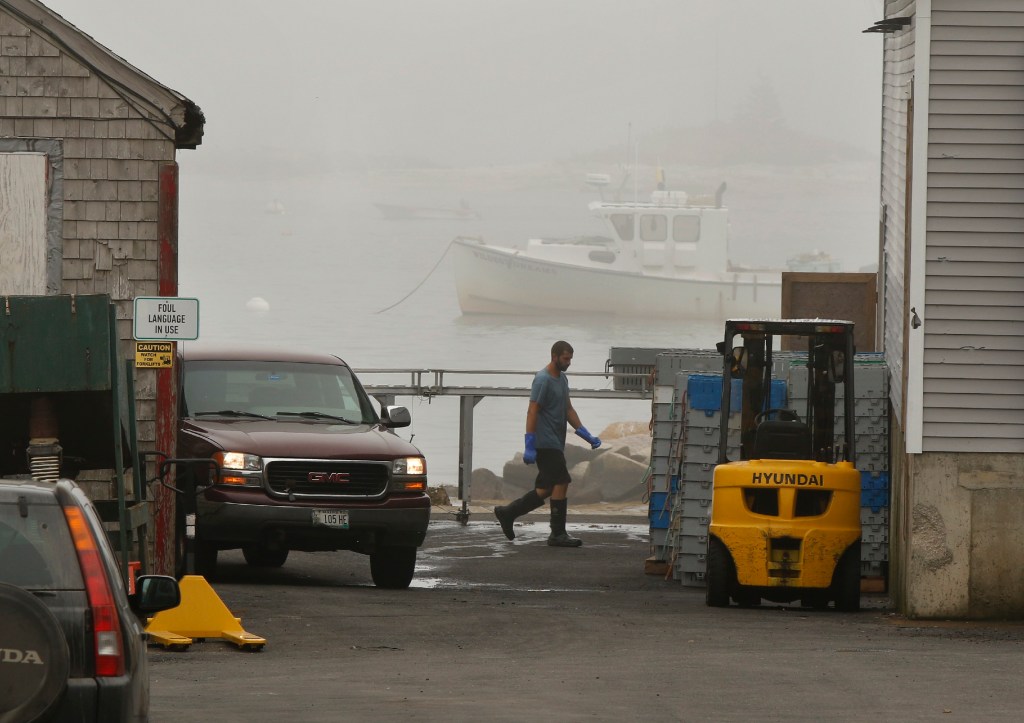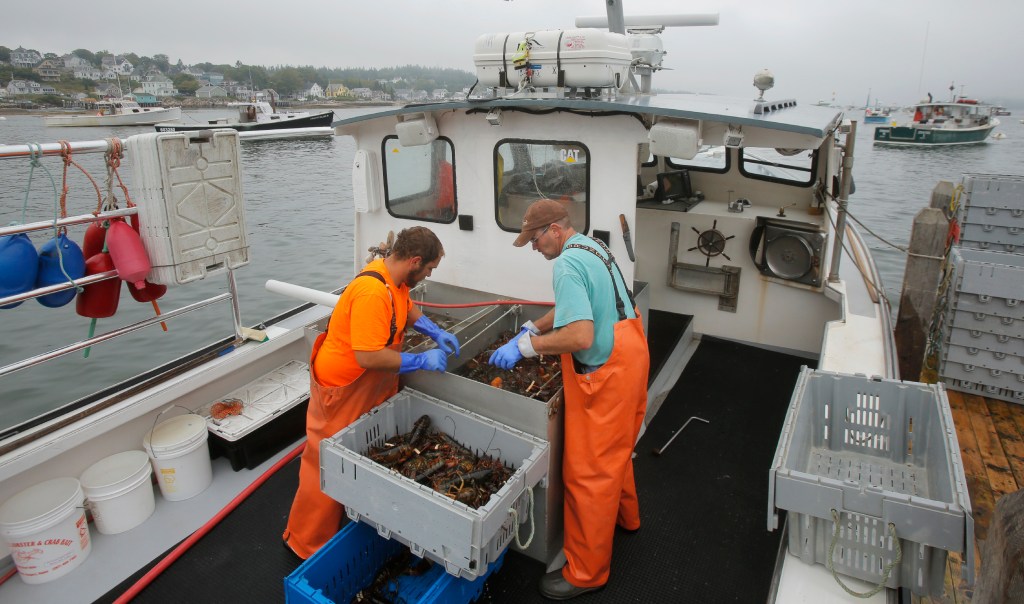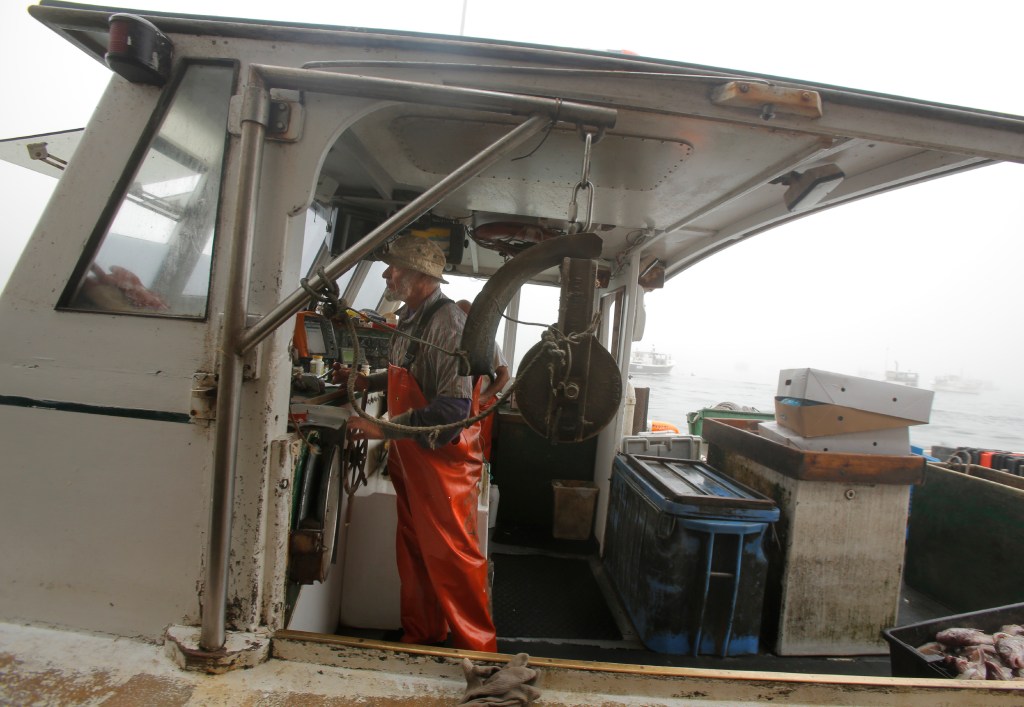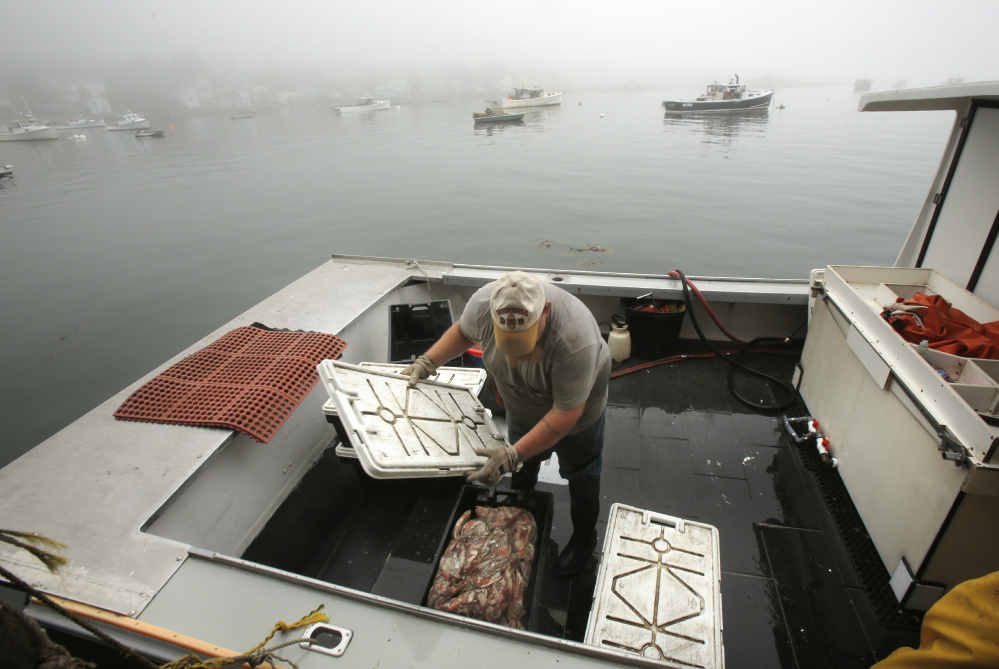STONINGTON — When Deer Isle lobsterman Jeff Eaton peers into one of his traps, he sees a lot more than snappers and selects, hard-shells and shedders.
The part-time boat builder and avid lobster boat racer sees the heart of a $126 million regional economy that supports an even larger network of trap makers, bait dealers, marine supply shopkeepers and boat builders like himself.
That trickle-down shadow economy has transformed the island, which used to be known best for the granite quarries that built New York and Washington, D.C.’s most iconic buildings, into a thriving lobster economy, now best known as the home to a 300-boat lobster fleet and the town of Stonington, the self-proclaimed lobster capital of the world.
“Up here, the lobster business trickles down a lot further than just us fishermen,” Eaton said. “It feeds the whole economy.”
Although postcard-beautiful, with its neat, century-old houses looking out over its blink-and-you’ve-missed-it downtown, Stonington is a fishing village first and a stomping ground for summer people second. It’s the leader of a regional economy that traps more than a third of all lobsters landed in Maine, and an equal percentage of all the dollars earned from their sale. Last year the value of the state’s catch reached nearly $500 million. This stretch of coastline, and the lobstering islands of Vinalhaven, Isle au Haut and North Haven, landed more lobsters than any other managed zone, and has done so for the last four years.
This is on Eaton’s mind as he weighs whether the state’s last open lobster fishing zone should make an apprentice wait for someone else to leave the fishery before getting a state license to set his own traps. The state’s other six regional lobster zones have waiting lists, some of which require apprentices to wait for up to a decade, or even longer. In July, Eaton’s fellow lobstermen in Zone C, which stretches from Sargentville east to Brooklin, voted to join the other zones and close, and last week the local lobster council followed suit and voted 6-1 to adopt a one-out, one-in waiting list system.
Like a majority of lobstermen who voted, Eaton wants to make sure there are enough lobsters to go around. He doesn’t like the idea of crowded waters, with people arguing over who gets to sink their traps where. He doesn’t want veteran fishermen who have carved out a life on the island to miss out on the good years when the landings and money are high because a newcomer wants to try his hand at lobstering, because the money earned in the good years will help them get through the inevitable bad years.
“I’m old enough to remember the bad years,” Eaton said.
BIGGER FLEET, MORE POWERFUL FISHERY
But a lot of lobstermen earning a good living is better for the fleet, and for the local economy, than a few lobstermen getting rich, Eaton said. As a lobsterman and a boat builder, Eaton can see both sides of the argument. He said he’s all right with closing the zone so long as the entry ratio – the number of licensed lobstermen who have to leave before a newcomer can get his or her license – is one to one. The zones with higher exit-to-entry ratios are known for the longest waiting lists, forcing sternmen, adult children who want to return home or anyone but a student lobsterman to wait for as long as a decade to get a license.
As the number of lobstermen increases, the power of the fishery grows, Eaton said. For example, a bait seller will load his herring, pogies and redfish on a truck and drive it to a port with a dozen lobstermen, but a dock that is home to just a few boats must get it themselves, he said. When the numbers climb as high as Deer Isle’s, which is home to a 300-boat lobster fleet, the support industry does more than just deliver; it opens up retail storefronts, giving a boost to the island’s economy.
Big numbers also give the industry more political power, Eaton said. Several dozen Stonington lobstermen with small operations who descend on the state Capitol have a louder voice than two or three big lobster boat skippers.
“It’s like a balancing act,” Eaton said. “We can’t get too big, but we can’t get too small, either.”
The decision on whether to close the state’s last open lobster zone now rests with Maine Department of Marine Resources Commissioner Patrick Keliher. He could enact a limited entry system, with a one-to-one entry ratio. He could change the entry ratio, requiring more than one lobsterman to give up his or her license before an apprentice can join the fishery. He could maintain the current licensing system. If he agrees to close the zone, it’s unlikely to reopen. None that have closed, from as early as 1997 to as late as 2004, have ever gotten rid of their wait lists.
AN OPEN ZONE DRAWS PEOPLE IN
Dave Jones thinks the zone should be kept open. The 42-year-old Stonington resident has always fished or scalloped, but he has only had his lobster license for four years. Standing aboard his boat, A Little Aud, sorting his day’s catch with sternman Felicia Taylor, Jones said he thought there was more than enough lobster to go around. Lobstering is doing so much better than Maine’s other fisheries, he said. Landings remain high, with state data showing this region landing 31.6 million pounds of lobster in 2015. Not as high as the year before, perhaps, but the region’s catch has increased dramatically over the last decade.
“It’s not fishing now, it’s harvesting,” Jones said, holding up a large “select” lobster in each hand, a reference to a lobster that weighs 2 to 2½ pounds. When one of the dock workers at Greenhead Lobster Co. dock in Stonington handed him his daily receipt, Jones pointed to it.
“There’s more than enough for everybody,” he said. “Today was a thousand-dollar day for me, which is pretty much my average, I wasn’t out there killing myself, so me, I’m pretty darn happy. I don’t need a new boat, new car, new house, new everything. I’m just happy, making a living.”
Jones mulls it over, holding a cold can of Bud Light that he just bought at the dock. He looks up at the houses overlooking the fogged-in harbor, many of which have been recently renovated, as he waits for another customer to finish up at the dock’s bait shop. He watches the fishermen from the boat that unloaded before him walk up to their new Ford trucks parked along Ocean Street. He didn’t weigh in with a paper ballot, and he doesn’t go to the local zone council meetings, but now that he takes a moment to look around, Jones said he thinks the island is making a big mistake.
He thinks keeping an open zone while others have closed has done great things for Stonington. It draws people here who want to fish, and that’s a good thing, he said. Without it, the bigger islands have only tourism, or what’s left of the granite quarries, to keep them afloat, say those who, like Jones, want to keep the zone open. And without the lure of a lobster license, the smaller islands, especially those without their own schools or ferries, have even less to draw new residents. Retirees buying summer homes won’t help sustain, much less grow, a small island’s year-round population.
“I think it’s better for Stonington to depend on the lobster than a tourist,” Jones said. “Without a big lobster fleet, we’ll end up turning into Bar Harbor, and the smaller islands, well, they won’t have anything to fall back on.”
WHAT IF ‘THE LOBSTERS GO AWAY’?
Council member Ted Ames, a lobsterman scientist who lives at the top of Thurlow’s Hill in Stonington, said he was worried about what might happen in the future if the council voted to close the zone now. Many people who had wanted the zone to remain open in the past agreed to close because of the one-to-one ratio, which gives newcomers some hope of getting a license after a few years of working on somebody else’s boat, but a future council could vote to bump up that ratio and claim the zone for themselves. It would be easier to change the ratio than to get the votes to close the zone, said Ames, who as a recently returning officer abstained from the council’s closure vote.
“A couple of very large fishermen is not a substitute for a whole town economy,” said Ames, who co-founded the zone lobster hatchery and won a MacArthur Fellowship, or a so-called genius grant, for research into the loss of productive fishing spawning grounds. “But on the other hand, there are only so many nail-pounding jobs that people could switch off to around here if the lobsters go away. … There comes a point when maybe you have to say enough is enough because Mother Nature can only produce so many lobsters in one season.”
MANEUVERING WITH THE TIMES
Many local lobstermen say the fishery is already overcrowded.
Francis Hardy of Stonington said there are so many traps set in local waters now that you can’t even kayak around the lobster buoys that blanket the shoreline shallows. David Tarr of Brooklin says he spends a lot of his day unsnarling his gear from others’. It’s now so crowded that Stonington is considering a downtown parking ban for fishermen, said Council Chairman Hilton Turner. With dock lots full, fishermen have been leaving their trucks parked all day in spots that downtown shops need to fill with tourists.
Bob Williams has been lobstering for 57 years. The 74-year-old Stonington native, who was inducted into the Stonington Fishermen’s Hall of Fame in 2013, has seen lean times, when you might check a day’s worth of traps and find only a few lobsters, as well as the recent boom. He talked about the need to control how many people can set traps while helping his sternman, John Larson, unload lobsters from his 38-foot wooden boat, Jamie-K, which is named after his youngest grandson. He said the fishery needs to take the long view because “the bugs” may not always be as plentiful as they are right now.
“Used to be I knew everybody out there on the water, but no more,” Williams said while pulling out a few hard-shells. “We can’t just be inviting everybody in. Others don’t, so why should we?”
He worries about the islands. But even lobster might not be enough to keep some of them year-round communities, Williams said. Too many of today’s young people want everything to be easy, and a life spent on a lobster boat isn’t easy, Williams said. He watched a Greenhead dock worker weigh one of his just-landed lobsters, which had two front claws as big as Larson’s hands. Larson had hoped he might top 5 pounds, but the hard-shell topped out at 4. The Serbian dockworkers that had gathered around the dockside scale groaned in disappointment.
“Yep, knew it,” Williams said with a smile and a giggle, his thumbs tucked behind the suspenders of his bright orange waders. “I got a pretty good eye for these kind of things. You want to think it’s bigger, but it’s not.”
It’s not just the old-timers who think the fishery should be closed. Daryl Dunham, a Deer Isle skipper of Force of Habit, is just 32 years old, and even though he said he was too busy to vote, he thinks it should be closed. This thin, fast-moving fisherman talked grudgingly about overcrowding, overregulation and overly curious visitors while he waited for the dockworkers to return with his daily receipts. As the rock band Quiet Riot blared over the boat radio, Dunham declared the limited-entry system, if adopted, would be the first time the government enacted a rule to protect the fishermen.
“Usually, the government cares more about the damn fish than about the people who catch them,” Dunham said. “Anything that keeps people who are already fishing able to pay their bills, I’m for that.”
Send questions/comments to the editors.
















